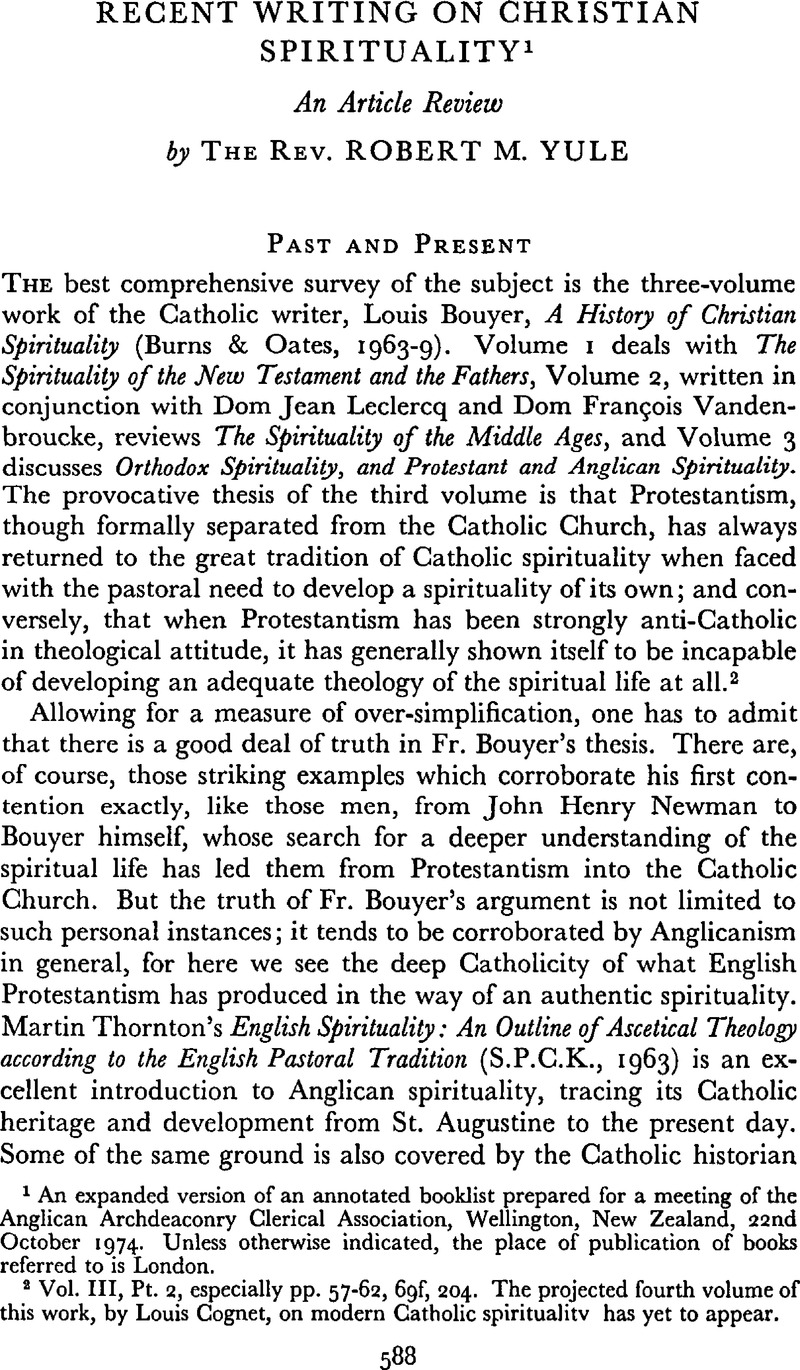No CrossRef data available.
Published online by Cambridge University Press: 02 February 2009

page 588 note 2 Vol. Ill, Pt. 2, especially pp. 57–62, 69f, 204. The projected fourth volume of this work, by Louis Cognet, on modern Catholic spiritualitv has yet to appear.
page note 1 Baelz, P., Prayer and Providence (S.C.M. Press, 1968)Google Scholar, Ellul, J., Prayer and Madern Man (New York: Seabury, 1970)Google Scholar
page 590 note 1 Harnack's view that mysticism was a pagan intrusion which accompanied the ‘hellenising’ of early Christianity colours his entire treatment of Christian spirituality: see History of Dogma (London, 1897–1899), especially Vol. Ill, pp. 163–178, Vol. IV, pp. 276–83, Vol. VI, pp. 10–15, 97–108Google Scholar. For the views of the other theologians mentioned, see Herrmann, W., The Communion of the Christian with God (London, 1895), pp. 17–46Google Scholar; Brunner, E., Die Mystik unddas Wort (Tübingen, 1928)Google Scholar; Bultmann, R., Jesus and the Word (London, 1958), pp. 41f, IIIfGoogle Scholar; Aulén, G., The Faith of the Christian Church (Philadelphia, 1948), pp. 50–52Google Scholar; Nygren, A., Agape and Eros (London, 1932–1939), especially Pt. I, pp. 158–182, Pt. II, pp. 208–30, 298–300, 355f. 415–19. 430–3, 444–6Google Scholar; Ebeling, G., Word and Faith (London, 1963), pp. 32–37Google Scholar; Moltmann, J., Theology of Hope (London, 1967), pp. 154–165.Google Scholar
Barth's attitude was at first coloured by the views of Harnack and Herrmann, his theological teachers. Thus in his earlier writings he rejected mysticism along with Pietism and Rationalism, as part of the immanentism of modern European culture (Protestant Theology in the Nineteenth Century, London, 1972, pp. 93–100, 113–23, 132–4) and as an intermediate step to modern atheism (Church Dogmatics, 1.2, pp. 318–25). But in his later writings, when he began to formulate his own understanding of sanctification and the Christian life, his attitude became more discerning and constructive. In CD. III.4, p. 59 he now distinguishes between Christian and non-Christian mysticism; in CD. IV. 1, p. 104 he confesses that ‘We need not be fanatically anti-mystical’; and in CD. IV.2, pp. 795–8 he admits that his earlier repudiation of mysticism (and even his earlier denigration of the human element in sanctification) was ‘sharp-sighted and rather severe’. Thus he gives qualified endorsement to the classical Protestant doctrine of the unio mystica, in the context of his exposition of sanctification (CD. IV.2, pp. 55–7, IV.3, pp. 539f). Where a critical attitude towards mysticism continues in Barth's later writings, it is usually associated with his reservations about monasticism (C.D. IV.2, pp. 11–19) and the contemplative life (CD. III.4, pp. 560–4).
page 590 note 2 See especially pp. 20–64.
page 591 note 1 Cf. Lovelace's, Richard article ‘The Sanctification Gap’, Theology Today, XXIX, 4 (January 1973), pp. 363–369.CrossRefGoogle Scholar
page 593 note 1 The address of the Fellowship is St. Basil's House, 52 Ladbroke Grove, London, WII 2PB. The counterpart in Scotland is the Fellowship of St. Andrew (1961).
page 595 note 1 Pp. 111–30. On the universal priesthood of all Christians in the Eastern tradition, cf. pp. 195–209.
page 595 note 2 In the case of Presbyterians this suspicion is not historically justified. For nearly a century after the Reformation daily morning and evening prayer continued to be held in most Scottish churches, using Knox's Book of Common Order, until the abandonment of this Prayer Book by the Westminster Assembly led to the cessation of daily services. Cf. Sprott, G. W., Worship and Offices of the Church of Scotland (Edinburgh, 1882), p. 263Google Scholar. But how many Presbyterians today are aware that its place was taken by a Directory of Family Worship, to foster equally regular family prayer?
page 597 note 1 Encounter with Spurgeon, p. 218.
page 598 note 1 Autumn Testament, p. 25.